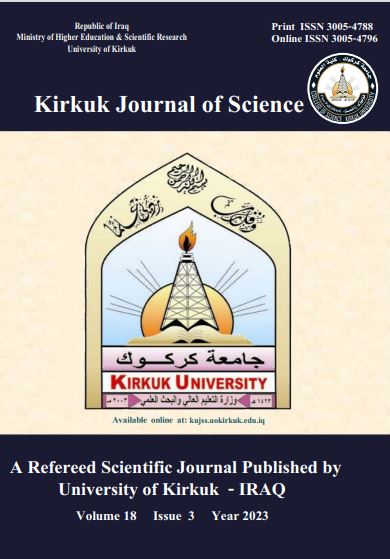Abstract
The analysis of trace element by x -ray fluorescence spectrometry always required appropriate
correction for matrix differences of the geological material . To reduce such effect , mass
absorption coefficient were calculated for both known (standards) and unknown samples.
Such calculation required analytical data of major element concentration (wt. %) . To make
these data available, is in fact time consuming job. Many theoretical and experimental corrections were attempted in order to save this additional analytical work . The uses of
incoherent scatter intensity dominate the relevant literature , because it is free of systematic
errors affecting the measurements of incoherent scatter intensity. Non of the published attempt
claimed routine uses of the suggested method of correction.
The present study deals with estimation of mass absorption coefficients of ten international
geological standards for wave length range ( 0.50A - 1. 66A ) using intensity (counts /40
seconds) of(GH;Mica-Fe;ATT-1;SY-2;ASk-1; ASk-2; BX-N; UM-2;UM-4;MRG-1) incoherent
scatter (I incoh) lines ( Au Lβ , Cr kβ , Mo Kα , Mo Kβ , W Lβ1 , WLβ2 ) reflected from smooth
surface of infinity thick pellets prepared from standards samples powders Appropriate
computer program were previously written and checked then , later used for computation of
mass absorption coefficients () of the standards samples. Sequential x-ray spectrometer
(PW1459/10) were used for measurements of incoherent Scatter (I incoh). The inverse relation
between (I incoh -) can be explained on the basis of low rate of incoherent scatter
generation from sample matrix of high mass absorption coefficient . Same matrix can absorb
great deal of departed x-ray from the samples . The curved relation is confined to Mo Kα and
Mo Kβ incoherent line resulted from the nature of the spectrometer pw 1450/10 used in this
study. Comparison between different incoherent reflection lines were made and the whole data
was subjected to additional mathematic and statistical treatments for improvement of results .
correction for matrix differences of the geological material . To reduce such effect , mass
absorption coefficient were calculated for both known (standards) and unknown samples.
Such calculation required analytical data of major element concentration (wt. %) . To make
these data available, is in fact time consuming job. Many theoretical and experimental corrections were attempted in order to save this additional analytical work . The uses of
incoherent scatter intensity dominate the relevant literature , because it is free of systematic
errors affecting the measurements of incoherent scatter intensity. Non of the published attempt
claimed routine uses of the suggested method of correction.
The present study deals with estimation of mass absorption coefficients of ten international
geological standards for wave length range ( 0.50A - 1. 66A ) using intensity (counts /40
seconds) of(GH;Mica-Fe;ATT-1;SY-2;ASk-1; ASk-2; BX-N; UM-2;UM-4;MRG-1) incoherent
scatter (I incoh) lines ( Au Lβ , Cr kβ , Mo Kα , Mo Kβ , W Lβ1 , WLβ2 ) reflected from smooth
surface of infinity thick pellets prepared from standards samples powders Appropriate
computer program were previously written and checked then , later used for computation of
mass absorption coefficients () of the standards samples. Sequential x-ray spectrometer
(PW1459/10) were used for measurements of incoherent Scatter (I incoh). The inverse relation
between (I incoh -) can be explained on the basis of low rate of incoherent scatter
generation from sample matrix of high mass absorption coefficient . Same matrix can absorb
great deal of departed x-ray from the samples . The curved relation is confined to Mo Kα and
Mo Kβ incoherent line resulted from the nature of the spectrometer pw 1450/10 used in this
study. Comparison between different incoherent reflection lines were made and the whole data
was subjected to additional mathematic and statistical treatments for improvement of results .
Keywords
mass absorption coefficient; trace element; x-ray fluorescence spectrometer ; incoherent scatter ; systematic errors
Abstract
يتطلب عادة تحليل العناصر الاثرية بمطياف الاشعة السينية الوميضية ،اجراء تصحيح تأثير اختلاف مادة الحشوة للمواد الجيولوجية. وللتقليل من هذا التأثير، بتم حساب معامل الامتصاص الكتلي لكل من النموذج القياسي والنموذج المطلوب تحليله . ان اجراء مثل هذه الحسابات يتطلب توفير بيانات تحليلية للمكونات الرئيسة من العناصر الكيميائية، وهو الامر الذي يضيف فترة زمنية اخرى تقترب او تزيد عن زمن التحليل المطلوب. وبهدف توفير هذا الجهد الاضافي ، جرت محاولات نظرية وتجريبية مختلفة. ويبدو ان محاولات استخدام الانعكاس اللاتوفقي هي الاكثر شيوعا في الادبيات ذات العلاقة وذلك لأنها خالية من الاخطاء النظامية المؤثرة على قياسات الانعكاس المتوافق ، غير ان اي من هذه المحاولات لم ترتقي الى الاستخدام الروتيني .تتناول الدراسة تقدير معامل الامتصاص الكتلي لعشرة نماذج جيولوجية قياسية عالمية : (GH; Mica-Fe; ATT-1; SY-2;ASk-1; ASk-2; BX-N; UM-2; UM-4; MRG-1)للأطوال الموجية (0.5-1.66) انكستروم وبتوظيف شدة الانعكاس اللاتوافقي (عدة/40 ثانية) لخطوط الاشعة : (AuLβ1; CrKβ; MoKα; MoKβ;WLβ1;WLβ2) من على اسطح لا منتهية السمك محضرة من مسحوق النماذج القياسية . ويلاحظ العلاقة العكسية في مرتسمات شدة الانعكاس اللاتوافقي مع معامل الامتصاص الكتلي المحسوب للنماذج القياسية بوساطة برنامج معد لذلك سلفا. ويمكن تفسير ذلك على اساس المعدلات المنخفضة لتوليد الانعكاس اللاتوافقي في حالة النماذج بحشوة عالية معامل الامتصاص الكتلي والتي تمتص ايضا، جزءا كبيرا من الشعاع الخارج او المغادر للنموذج. وينفرد الانعكاس اللاتوافقي لخطي beta وMoK alpha بعلاقة منحنية مع معامل الامتصاص الكتلي. وهذا يعود الى طبيعة مطياف الاشعة السينية الوميضية PW1450/10 المستخدم في الدراسة الحالية . وخضعت البيانات الى معالجات اضافية رياضية واحصائية فضلا عن المفاضلة بين الانعكاسات المختلفة بهدف تحسين النتائج .
Keywords
العناصر الاثرية
اللاتوافقي الاخطاء النظامية
الوميضية الانعكاس
مطياف الاشعة السينية
معامل الامتصاص الكتلي
